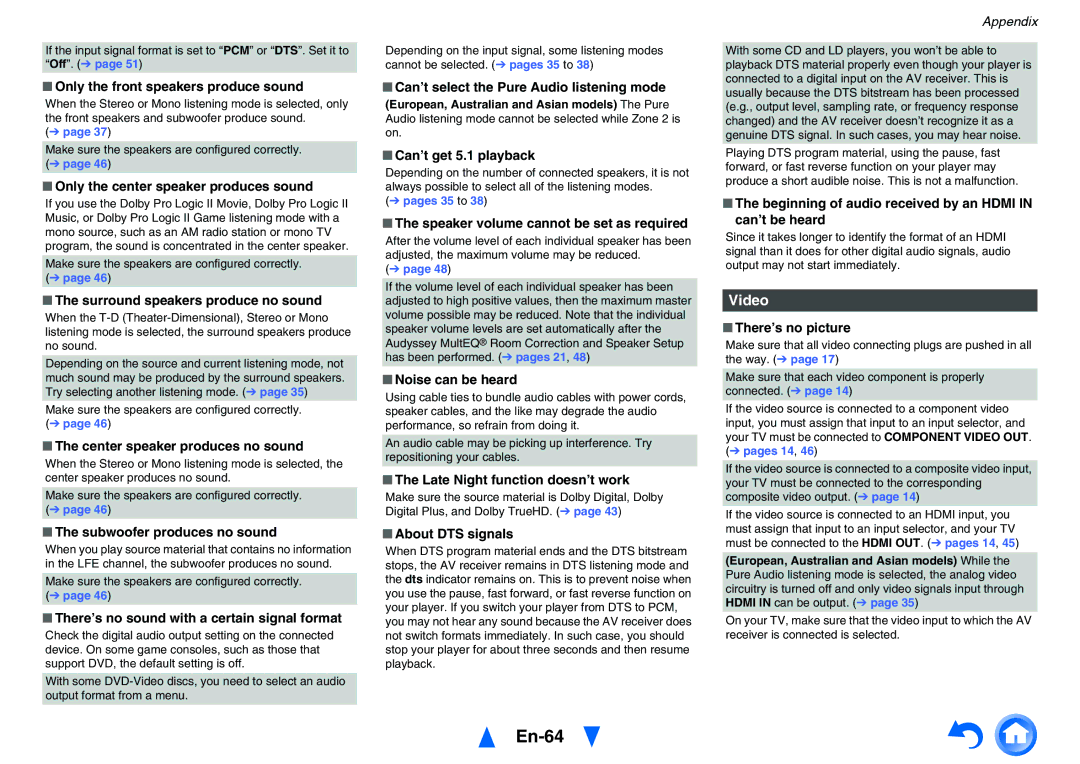
If the input signal format is set to “PCM” or “DTS”. Set it to “Off”. (➔ page 51)
■Only the front speakers produce sound
When the Stereo or Mono listening mode is selected, only the front speakers and subwoofer produce sound.
(➔ page 37)
Make sure the speakers are configured correctly. (➔ page 46)
■Only the center speaker produces sound
If you use the Dolby Pro Logic II Movie, Dolby Pro Logic II Music, or Dolby Pro Logic II Game listening mode with a mono source, such as an AM radio station or mono TV program, the sound is concentrated in the center speaker.
Make sure the speakers are configured correctly. (➔ page 46)
■The surround speakers produce no sound
When the
Depending on the source and current listening mode, not much sound may be produced by the surround speakers. Try selecting another listening mode. (➔ page 35)
Make sure the speakers are configured correctly. (➔ page 46)
■The center speaker produces no sound
When the Stereo or Mono listening mode is selected, the center speaker produces no sound.
Make sure the speakers are configured correctly. (➔ page 46)
■The subwoofer produces no sound
When you play source material that contains no information in the LFE channel, the subwoofer produces no sound.
Make sure the speakers are configured correctly. (➔ page 46)
■There’s no sound with a certain signal format
Check the digital audio output setting on the connected device. On some game consoles, such as those that support DVD, the default setting is off.
With some
Depending on the input signal, some listening modes cannot be selected. (➔ pages 35 to 38)
■Can’t select the Pure Audio listening mode
(European, Australian and Asian models) The Pure Audio listening mode cannot be selected while Zone 2 is on.
■Can’t get 5.1 playback
Depending on the number of connected speakers, it is not always possible to select all of the listening modes.
(➔ pages 35 to 38)
■The speaker volume cannot be set as required
After the volume level of each individual speaker has been adjusted, the maximum volume may be reduced.
(➔ page 48)
If the volume level of each individual speaker has been adjusted to high positive values, then the maximum master volume possible may be reduced. Note that the individual speaker volume levels are set automatically after the Audyssey MultEQ® Room Correction and Speaker Setup has been performed. (➔ pages 21, 48)
■Noise can be heard
Using cable ties to bundle audio cables with power cords, speaker cables, and the like may degrade the audio performance, so refrain from doing it.
An audio cable may be picking up interference. Try repositioning your cables.
■The Late Night function doesn’t work
Make sure the source material is Dolby Digital, Dolby Digital Plus, and Dolby TrueHD. (➔ page 43)
■About DTS signals
When DTS program material ends and the DTS bitstream stops, the AV receiver remains in DTS listening mode and the dts indicator remains on. This is to prevent noise when you use the pause, fast forward, or fast reverse function on your player. If you switch your player from DTS to PCM, you may not hear any sound because the AV receiver does not switch formats immediately. In such case, you should stop your player for about three seconds and then resume playback.
En-64
Appendix
With some CD and LD players, you won’t be able to playback DTS material properly even though your player is connected to a digital input on the AV receiver. This is usually because the DTS bitstream has been processed (e.g., output level, sampling rate, or frequency response changed) and the AV receiver doesn’t recognize it as a genuine DTS signal. In such cases, you may hear noise.
Playing DTS program material, using the pause, fast forward, or fast reverse function on your player may produce a short audible noise. This is not a malfunction.
■The beginning of audio received by an HDMI IN can’t be heard
Since it takes longer to identify the format of an HDMI signal than it does for other digital audio signals, audio output may not start immediately.
Video
■There’s no picture
Make sure that all video connecting plugs are pushed in all the way. (➔ page 17)
Make sure that each video component is properly connected. (➔ page 14)
If the video source is connected to a component video input, you must assign that input to an input selector, and your TV must be connected to COMPONENT VIDEO OUT. (➔ pages 14, 46)
If the video source is connected to a composite video input, your TV must be connected to the corresponding composite video output. (➔ page 14)
If the video source is connected to an HDMI input, you must assign that input to an input selector, and your TV must be connected to the HDMI OUT. (➔ pages 14, 45)
(European, Australian and Asian models) While the Pure Audio listening mode is selected, the analog video circuitry is turned off and only video signals input through HDMI IN can be output. (➔ page 35)
On your TV, make sure that the video input to which the AV receiver is connected is selected.
